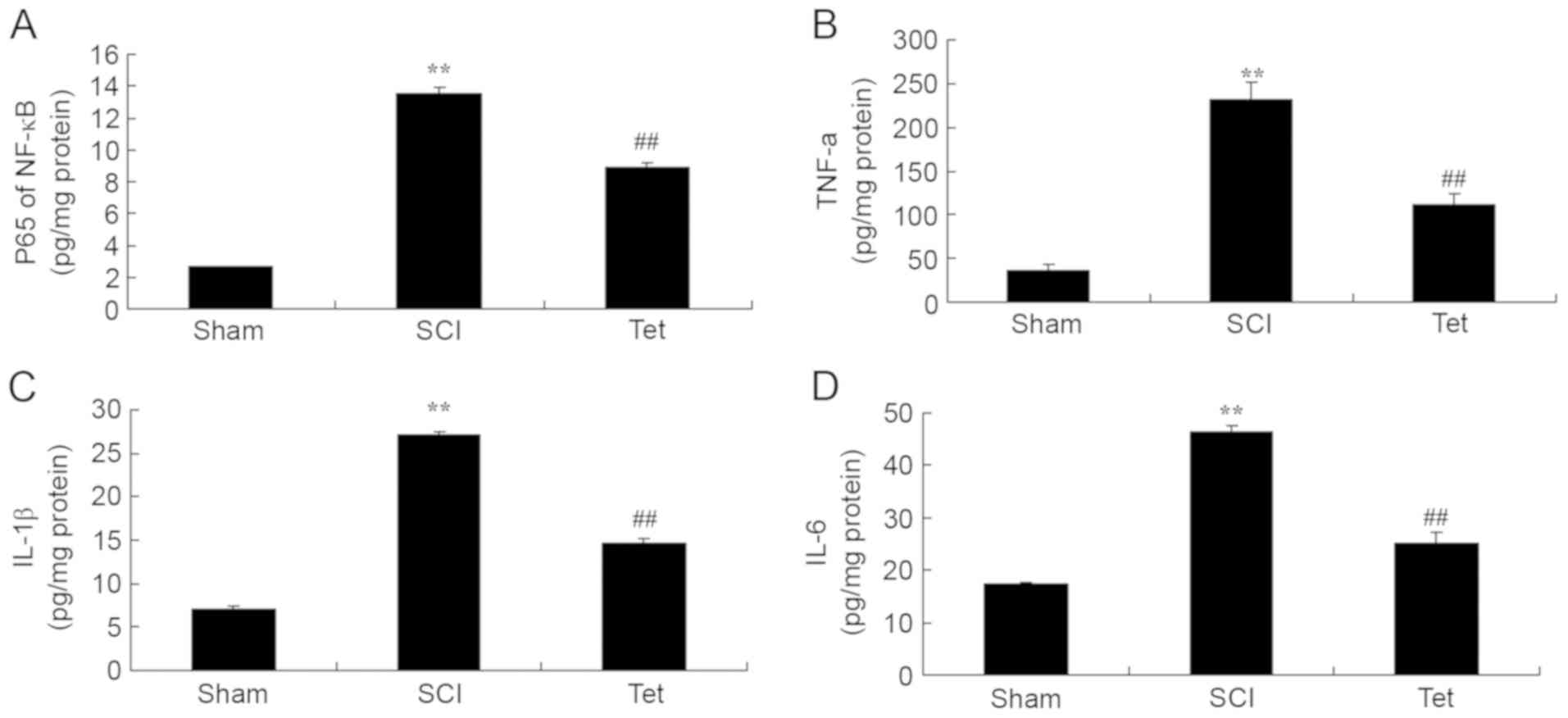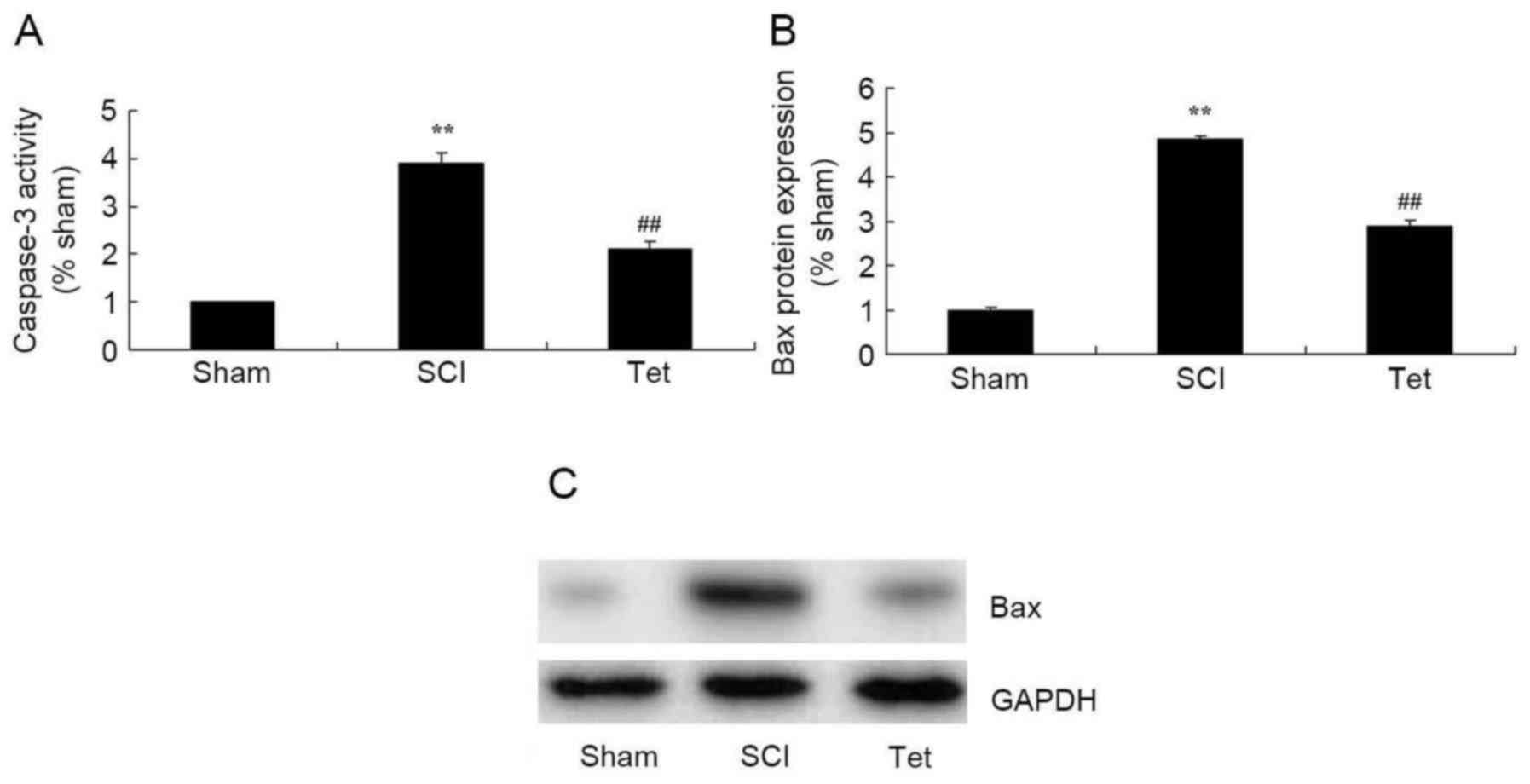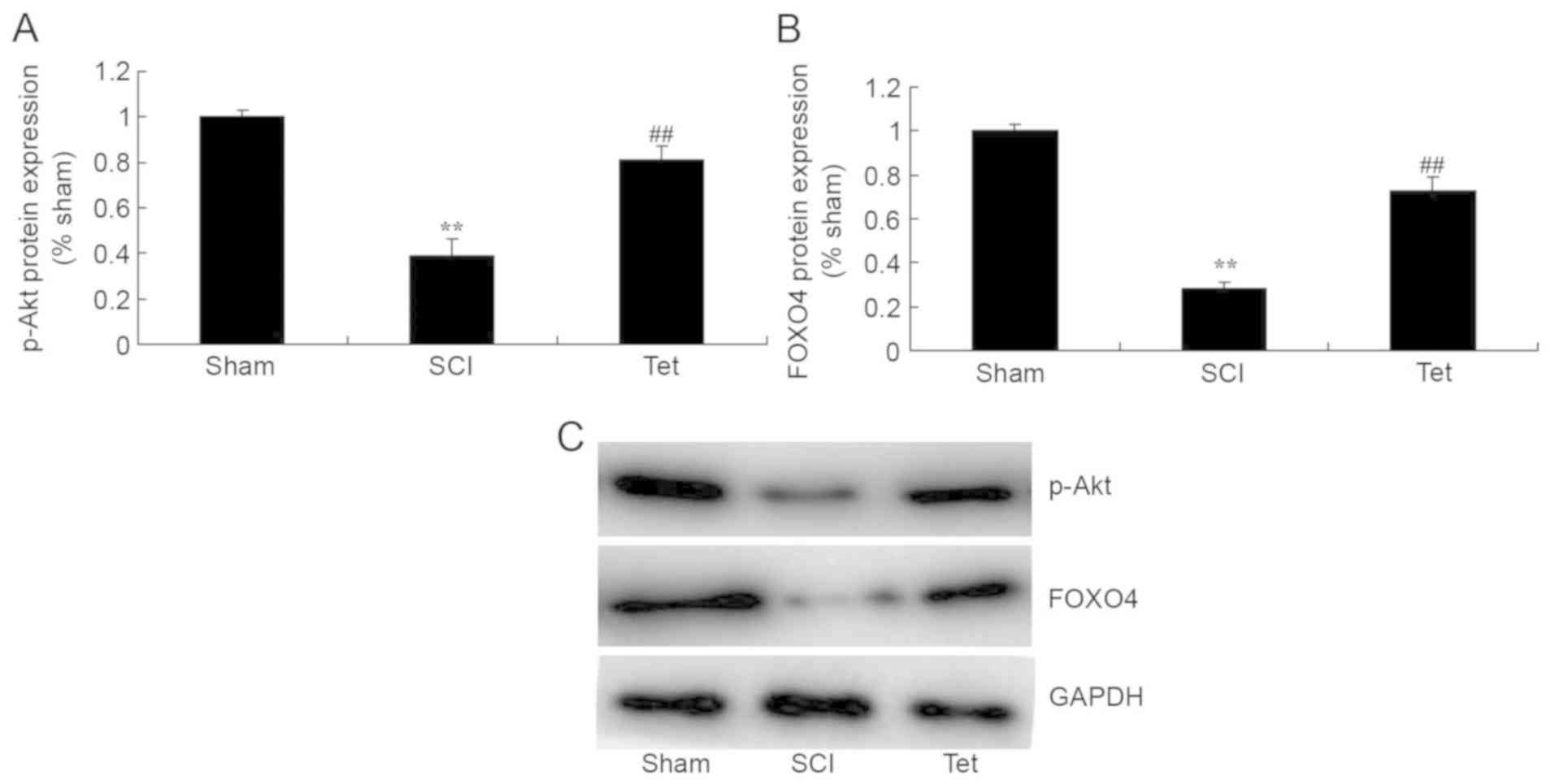|
1
|
Jiang W, Huang Y, He F, Liu J, Li M, Sun
T, Ren W, Hou J and Zhu L: Dopamine D1 receptor agonist A-68930
inhibits NLRP3 inflammasome activation, controls inflammation, and
alleviates histopathology in a rat model of spinal cord injury.
Spine (Phila Pa 1976). 41:E330–E334. 2016. View Article : Google Scholar : PubMed/NCBI
|
|
2
|
Hossain MS, Harvey LA, Rahman MA, Muldoon
S, Bowden JL, Islam MS, Jan S, Taylor V, Cameron ID, Chhabra HS, et
al: Community-based InterVentions to prevent serIous Complications
(CIVIC) following spinal cord injury in Bangladesh: Protocol of a
randomised controlled trial. BMJ Open. 6:e0103502016. View Article : Google Scholar : PubMed/NCBI
|
|
3
|
Jan YK and Crane BA: Wheelchair
tilt-in-space and recline does not reduce sacral skin perfusion as
changing from the upright to the tilted and reclined position in
people with spinal cord injury. Arch Phys Med Rehabil.
94:1207–1210. 2013. View Article : Google Scholar : PubMed/NCBI
|
|
4
|
Triolo RJ, Bailey SN, Miller ME, Rohde LM,
Anderson JS, Davis JA Jr, Abbas JJ, DiPonio LA, Forrest GP, Gater
DR Jr and Yang LJ: Longitudinal performance of a surgically
implanted neuroprosthesis for lower-extremity exercise, standing,
and transfers after spinal cord injury. Arch Phys Med Rehabil.
93:896–904. 2012. View Article : Google Scholar : PubMed/NCBI
|
|
5
|
Kressler J, Nash MS, Burns PA and
Field-Fote EC: Metabolic responses to 4 different body
weight-supported locomotor training approaches in persons with
incomplete spinal cord injury. Arch Phys Med Rehabil. 94:1436–1442.
2013. View Article : Google Scholar : PubMed/NCBI
|
|
6
|
Wang S, Lu J, Li YA, Zhou H, Ni WF, Zhang
XL, Zhu SP, Chen BB, Xu H, Wang XY, et al: Autologous olfactory
lamina propria transplantation for chronic spinal cord injury:
Three-year follow-up outcomes from a prospective double-blinded
clinical trial. Cell Transplant. 25:141–157. 2016. View Article : Google Scholar : PubMed/NCBI
|
|
7
|
Xia M and Zhu Y: FOXO3a involvement in the
release of TNF-α stimulated by ATP in spinal cord astrocytes. J Mol
Neurosci. 51:792–804. 2013. View Article : Google Scholar : PubMed/NCBI
|
|
8
|
Zhang S, Huan W, Wei H, Shi J, Fan J, Zhao
J, Shen A and Teng H: FOXO3a/p27kip1 expression and essential role
after acute spinal cord injury in adult rat. J Cell Biochem.
114:354–365. 2013. View Article : Google Scholar : PubMed/NCBI
|
|
9
|
Léger B, Senese R, Al-Khodairy AW, Dériaz
O, Gobelet C, Giacobino JP and Russell AP: Atrogin-1, MuRF1, and
FoXO, as well as phosphorylated GSK-3beta and 4E-BP1 are reduced in
skeletal muscle of chronic spinal cord-injured patients. Muscle
Nerve. 40:69–78. 2009. View Article : Google Scholar : PubMed/NCBI
|
|
10
|
Sangartit W, Kukongviriyapan U, Donpunha
W, Pakdeechote P, Kukongviriyapan V, Surawattanawan P and Greenwald
SE: Tetrahydrocurcumin protects against cadmium-induced
hypertension, raised arterial stiffness and vascular remodeling in
mice. PLoS One. 9:e1149082014. View Article : Google Scholar : PubMed/NCBI
|
|
11
|
Park S, Lee LR, Seo JH and Kang S:
Curcumin and tetrahydrocurcumin both prevent osteoarthritis
symptoms and decrease the expressions of pro-inflammatory cytokines
in estrogen-deficient rats. Genes Nutr. 11:22016. View Article : Google Scholar : PubMed/NCBI
|
|
12
|
Wu JC, Lai CS, Badmaev V, Nagabhushanam K,
Ho CT and Pan MH: Tetrahydrocurcumin, a major metabolite of
curcumin, induced autophagic cell death through coordinative
modulation of PI3K/Akt-mTOR and MAPK signaling pathways in human
leukemia HL-60 cells. Mol Nutr Food Res. 55:1646–1654. 2011.
View Article : Google Scholar : PubMed/NCBI
|
|
13
|
Xiang L, Nakamura Y, Lim YM, Yamasaki Y,
Kurokawa-Nose Y, Maruyama W, Osawa T, Matsuura A, Motoyama N and
Tsuda L: Tetrahydrocurcumin extends life span and inhibits the
oxidative stress response by regulating the FOXO forkhead
transcription factor. Aging (Albany NY). 3:1098–1109. 2011.
View Article : Google Scholar : PubMed/NCBI
|
|
14
|
Mukhamedshina YO, Akhmetzyanova ER,
Kostennikov AA, Zakirova EY, Galieva LR, Garanina EE, Rogozin AA,
Kiassov AP and Rizvanov AA: Adipose-derived mesenchymal stem cell
application combined with fibrin matrix promotes structural and
functional recovery following spinal cord injury in rats. Front
Pharmacol. 9:3432018. View Article : Google Scholar : PubMed/NCBI
|
|
15
|
Sharp KG, Gramer R, Butler L, Cramer SC,
Hade E and Page SJ: Effect of overground training augmented by
mental practice on gait velocity in chronic, incomplete spinal cord
injury. Arch Phys Med Rehabil. 95:615–621. 2014. View Article : Google Scholar : PubMed/NCBI
|
|
16
|
van der Scheer JW, de Groot S, Tepper M,
Faber W; ALLRISC group, ; Veeger DH and van der Woude LH:
Low-intensity wheelchair training in inactive people with long-term
spinal cord injury: A randomized controlled trial on fitness,
wheelchair skill performance and physical activity levels. J
Rehabil Med. 48:33–42. 2016. View Article : Google Scholar : PubMed/NCBI
|
|
17
|
Shin JC, Kim KN, Yoo J, Kim IS, Yun S, Lee
H, Jung K, Hwang K, Kim M, Lee IS, et al: Clinical trial of human
fetal brain-derived neural stem/progenitor cell transplantation in
patients with traumatic cervical spinal cord injury. Neural Plast.
2015:6309322015. View Article : Google Scholar : PubMed/NCBI
|
|
18
|
Murai T, Murata R, Manabe Y, Sugie C,
Tamura T, Ito H, Miyoshi Y and Shibamoto Y: Intensity modulated
stereotactic body radiation therapy for single or multiple
vertebral metastases with spinal cord compression. Pract Radiat
Oncol. 4:e231–e237. 2014. View Article : Google Scholar : PubMed/NCBI
|
|
19
|
Zheng B, Ye L, Zhou Y, Zhu S, Wang Q, Shi
H, Chen D, Wei X, Wang Z, Li X, et al: Epidermal growth factor
attenuates blood-spinal cord barrier disruption via PI3K/Akt/Rac1
pathway after acute spinal cord injury. J Cell Mol Med.
20:1062–1075. 2016. View Article : Google Scholar : PubMed/NCBI
|
|
20
|
Miranpuri GS, Schomberg DT, Alrfaei B,
King KC, Rynearson B, Wesley VS, Khan N, Obiakor K, Wesley UV and
Resnick DK: Role of matrix metalloproteinases 2 in spinal cord
injury-induced neuropathic pain. Ann Neurosci. 23:25–32. 2016.
View Article : Google Scholar : PubMed/NCBI
|
|
21
|
Schreiber R, Paim LR, de Rossi G,
Matos-Souza JR, Costa E Silva Ade A, Souza CM, Borges M, Azevedo
ER, Alonso KC, Gorla JI, et al: Matrix metalloproteinases and left
ventricular function and structure in spinal cord injured subjects.
Clin Chim Acta. 437:136–140. 2014. View Article : Google Scholar : PubMed/NCBI
|
|
22
|
Zhang H, Chu G, Pan C, Hu J, Guo C, Liu J,
Wang Y and Wu J: A nutrient mixture reduces the expression of
matrix metalloproteinases in an animal model of spinal cord injury
by modulating matrix metalloproteinase-2 and matrix
metalloproteinase-9 promoter activities. Exp Ther Med. 8:1835–1840.
2014. View Article : Google Scholar : PubMed/NCBI
|
|
23
|
Lee JY, Kim HS, Oh TH and Yune TY: Ethanol
extract of Bupleurum falcatum improves functional recovery by
inhibiting matrix metalloproteinases-2 and −9 activation and
inflammation after spinal cord injury. Exp Neurobiol. 19:146–154.
2010. View Article : Google Scholar : PubMed/NCBI
|
|
24
|
Cirillo G, Colangelo AM, De Luca C,
Savarese L, Barillari MR, Alberghina L and Papa M: Modulation of
matrix metalloproteinases activity in the ventral horn of the
spinal cord re-stores neuroglial synaptic homeostasis and
neurotrophic support following peripheral nerve injury. PLoS One.
11:e01527502016. View Article : Google Scholar : PubMed/NCBI
|
|
25
|
Yodkeeree S, Garbisa S and Limtrakul P:
Tetrahydrocurcumin inhibits HT1080 cell migration and invasion via
downregulation of MMPs and uPA. Acta Pharmacol Sin. 29:853–860.
2008. View Article : Google Scholar : PubMed/NCBI
|
|
26
|
Sun Z, Yan B, Yu WY, Yao X, Ma X, Sheng G
and Ma Q: Vitexin attenuates acute doxorubicin cardiotoxicity in
rats via the suppression of oxidative stress, inflammation and
apoptosis and the activation of FOXO3a. Exp Ther Med. 12:1879–1884.
2016. View Article : Google Scholar : PubMed/NCBI
|
|
27
|
Luo L, Lu AM, Wang Y, Hong A, Chen Y, Hu
J, Li X and Qin ZH: Chronic resistance training activates autophagy
and reduces apoptosis of muscle cells by modulating IGF-1 and its
receptors, Akt/mTOR and Akt/FOXO3a signaling in aged rats. Exp
Gerontol. 48:427–436. 2013. View Article : Google Scholar : PubMed/NCBI
|
|
28
|
Yoshihara T, Kobayashi H, Kakigi R,
Sugiura T and Naito H: Heat stress-induced phosphorylation of
FoxO3a signalling in rat skeletal muscle. Acta Physiol (Oxf).
218:178–187. 2016. View Article : Google Scholar : PubMed/NCBI
|
|
29
|
Luan Y, Chen M and Zhou L: MiR-17 targets
PTEN and facilitates glial scar formation after spinal cord
injuries via the PI3K/Akt/mTOR pathway. Brain Res Bull. 128:68–75.
2016. View Article : Google Scholar : PubMed/NCBI
|
|
30
|
Chen CH, Sung CS, Huang SY, Feng CW, Hung
HC, Yang SN, Chen NF, Tai MH, Wen ZH and Chen WF: The role of the
PI3K/Akt/mTOR pathway in glial scar formation following spinal cord
injury. Exp Neurol. 278:27–41. 2016. View Article : Google Scholar : PubMed/NCBI
|
















